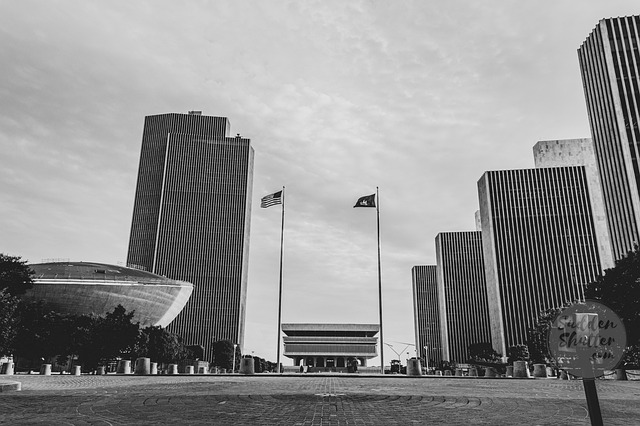Graphic designers in Albany require print-readiness skills, combining visual artistry and technical expertise for diverse print methods. They cater to specific client needs, follow industry standards, and adopt sustainable practices. To prepare print-ready files, save in CMYK high-resolution, ensure 300 DPI images, use grids, and embed fonts. Optimizing images with 300 DPI, CMYK color profiles, and vector graphics ensures accurate prints. Color Management is vital for consistent hue accuracy. Designers create effective layouts using correct color modes and resolutions to prevent printing issues. Avoid common mistakes like low res images, neglecting bleeds, and incorrect color modes for professional results.
“For graphic designers in Albany, preparing print-ready files is a crucial skill. This comprehensive guide navigates the essentials of creating high-quality graphics for commercial printing services in Albany. From understanding file requirements to optimizing images and ensuring color accuracy, we cover all aspects. Learn how to prepare layouts effectively, avoid common mistakes, and master the art of print production in Albany, enhancing your design offerings for clients.”
- Understanding Print-Readiness for Graphic Designers in Albany
- Essential Elements of a High-Quality Print File
- Optimizing Images for Print Production in Albany
- Color Management: Ensuring Accurate Reproductions
- Preparing Layouts for Commercial Printing Services
- Common Mistakes to Avoid When Creating Print Files
Understanding Print-Readiness for Graphic Designers in Albany

In Albany, for a graphic designer, print-readiness is paramount. It’s not just about creating visually stunning designs; it’s ensuring that those designs translate flawlessly from digital to physical formats. This involves understanding color management, resolution requirements, and file formatting for various print methods. Graphic designers in Albany often work with clients who have specific needs and expectations for their printed materials, whether it’s a sleek brochure or a vibrant poster. Staying updated on industry standards and best practices is crucial for delivering high-quality prints that meet client demands and boost their brand visibility.
Beyond technical proficiency, print-readiness also encompasses embracing sustainable graphic design practices. Albany’s designers are increasingly incorporating eco-friendly materials and methods into their workflows. This not only aligns with growing environmental consciousness but also opens up opportunities to appeal to clients who prioritize sustainability. With the fusion of web design and graphic design becoming more pronounced, graphic designers in Albany must adapt by integrating digital elements seamlessly into print-ready files, ensuring a cohesive brand experience across various media platforms.
Essential Elements of a High-Quality Print File

When preparing a print-ready file for a project with a local graphic designer in Albany, such as those at Brawn Media, or for upcoming design events in Albany, it’s crucial to include several essential elements. Firstly, ensure your file is saved in a high-resolution format like CMYK, which is the standard for printing. This guarantees that your colours appear accurately on the final product. Secondly, check the resolution of all images; 300 DPI (dots per inch) is the minimum recommended for crisp, professional prints.
Additionally, pay close attention to the layout and design. Ensure there are adequate margins around the cut lines or trim edges to avoid important content being cut off. Use a grid system or guidelines to maintain consistency in placement and sizing of elements. Lastly, double-check your file for any fonts used; embed all fonts or provide the font files to ensure the design renders correctly during printing. These considerations will help produce high-quality prints that reflect well on Albany’s top marketing agencies and local graphic designers.
Optimizing Images for Print Production in Albany

When preparing print-ready files for Albany’s graphic designers and print production houses, optimizing images is a crucial step that cannot be overlooked. High-quality prints rely on crisp, well-resized, and properly formatted visuals. Start by ensuring all images are at 300 DPI (dots per inch) resolution, the industry standard for sharp, detailed prints. This setting guarantees that your designs will look flawless when scaled up during the printing process.
Leveraging design thinking workshops and creative direction from experts in Albany can significantly enhance this process. User interface (UI) design specialists in the city offer valuable insights into color management and file optimization techniques. They advocate for using industry-standard color profiles, such as CMYK, to ensure accurate color representation across various print mediums. Additionally, these professionals recommend utilizing vector graphics whenever possible, as they scale smoothly without sacrificing quality, making them ideal for both digital and print applications.
Color Management: Ensuring Accurate Reproductions

Color Management: Ensuring Accurate Reproductions
As a graphic designer in Albany, your work is only as good as its final print output. One of the most crucial aspects of achieving exceptional results is proper color management. This involves understanding and implementing strategies to maintain consistent and accurate colors across various devices and mediums. With the help of top-rated graphic artists in Albany, you can ensure that your designs translate perfectly from digital screens to physical prints.
At a leading print design studio Albany, professionals utilize advanced techniques such as color profiles, calibrations, and proofing methods to manage colors effectively. A branding agency with a creative team in Albany should also prioritize these practices to deliver high-quality materials for their clients. By maintaining precise control over the color spectrum, graphic designers can produce vibrant, accurate prints that meet client expectations every time.
Preparing Layouts for Commercial Printing Services

Preparing layouts for commercial printing services is a crucial step that requires careful consideration from Albany’s graphic designers. When working with print-ready files, ensuring your designs are optimized for the specific printing process is essential. This involves using the right color modes (CMYK for most commercial prints), setting appropriate resolution standards (typically 300 DPI for high-quality results), and following industry best practices to avoid issues like pixelation or banding.
Graphic designers in Albany play a vital role in crafting visually appealing and print-ready layouts, especially for startups requiring custom graphic design solutions. They collaborate closely with clients to understand their brand identity, target audience, and desired outcome. Whether it’s designing a captivating brochure for a local business or developing e-commerce graphic design solutions for an online retailer, these professionals use their expertise to create layouts that not only meet but exceed printing expectations, ensuring the final product looks as intended on paper.
Common Mistakes to Avoid When Creating Print Files

When preparing print-ready files for a graphic designer Albany or environmental graphics designers Albany, there are several common mistakes to avoid that can cause delays and subpar results. One of the biggest blunders is not providing high-resolution files, as this can lead to pixelation and a loss of detail when printed. Always ensure your designs are saved at the appropriate resolution for their intended use; 300 DPI (dots per inch) is typically the standard for quality printing.
Another frequent error is neglecting to include bleeds, which are the extra areas around the edges of a design that prevent white borders from appearing when pages are cut. Bleeds ensure your designs look clean and professional when printed. Additionally, local business branding packages Albany specialists recommend using the correct color mode (CMYK for print) and checking your file for any remaining vector elements or raster images at 300 DPI or higher. For a print design studio Albany to work efficiently, these simple precautions can save time and ensure your final print products meet professional standards.
When preparing print-ready files for graphic designers in Albany, it’s crucial to follow best practices outlined in this guide. From optimizing images for print production to ensuring color management accuracy, each step is vital for achieving high-quality results. By understanding the essential elements and common mistakes to avoid, you can collaborate effectively with commercial printing services in Albany to deliver exceptional print materials that meet your design vision. Remember, the right preparation can make all the difference in the final output, ensuring your designs look as intended on printed media.














